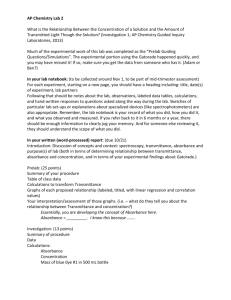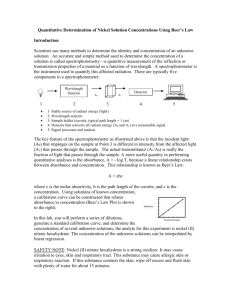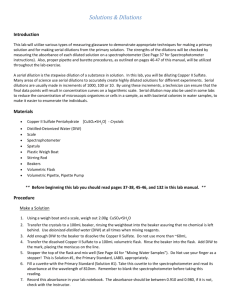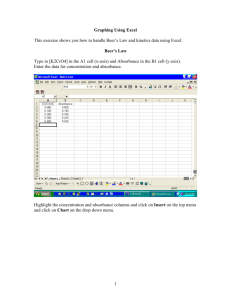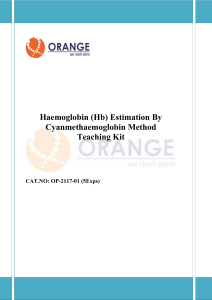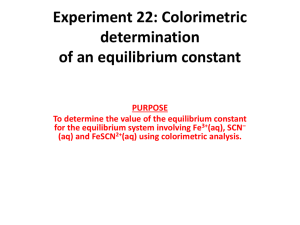Fundamentals
advertisement
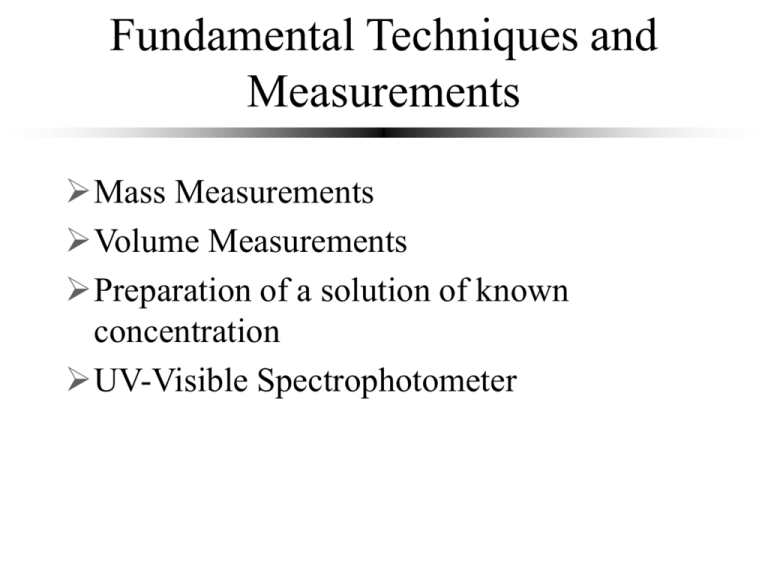
Fundamental Techniques and Measurements Mass Measurements Volume Measurements Preparation of a solution of known concentration UV-Visible Spectrophotometer Electronic Balance What does an electronic balance measure? _____ force If you took an electronic balance with a capacity of 100 g to the moon what would its range be? _____ 600 g Mass: Electronic Balance Accuracy 4 to 6 significant digits Calibration Use known mass Check weekly or when balance is moved Sources of error Balance must be calibrated and maintained in same orientation in _________ field gravity hydroscopic chemicals: dry to constant mass first (will increase in mass rapidly as they reabsorb water on the balance!) When preparing a solution of a given concentration it may be difficult to get report actual! the exact mass desired_________ evaporation of wet samples Electronic Balance M o d el D I-100 D I-800 D I-5000 Cap acity Reso lutio n 100 g 0.0001 g 800 g 0.01 g 5000 g 0.1 g For maximum accuracy use balance with lowest _______ capacity possible! Don’t forget to clean the balance if you spill any chemicals!!!!!! Volume Volumetric flask 0.16 mL accuracy of ______/100 mL Graduated cylinder 1 mL accuracy of ______/100 mL Beaker 5 mL accuracy of _____/100 mL Pipette What will accuracy of solution be if you use pipette, volumetric flask, and electronic 1% balance? ________ What controls the Pipette accuracy? _______ 0.6% for 100-1000 µL accuracy of ± _____ 0.8% for 10-100 µl accuracy of ± _____ Digital Pipettes Air displacement Do not directly contact fluid volume avoids contamination of pipette avoids sample carryover Require air tight connection between tip and body Pipette Workings piston cylinder Pipette tip Pipettes: Sources of Error Jetting Incorrect transfer technique (getting too much sample) Wipe tip on container to remove droplets Contamination from previous samples Viscous fluids Hot or cold fluids Fluids with high vapor pressure Keep Pipette vertical! Preparation of Solutions Example: Prepare 100 mL of a 30 mM solution of methylene blue. The molecular weight of methylene blue (C16H18N3SCl) is 319.87 g. CV M 30 x 10-3 mole MB 319.87 g MB mole MB L concentration conversion 100 x 10-3 L = 0.9596 g MB volume mass Preparation of Dilutions Prepare 100 mL of a 300 µM solution from the 30 mM solution mass Conservation of _____ M dilute M concentrat e CdiluteVdilute Cconcentrat eVconcentrat e Vconcentrate Vconcentrate CdiluteVdilute Cconcentrate 300 M fa 100 mLf a a30 mMf = 1 mL Preparation of Solutions Fill volumetric flask half way with distilled water Add reagent (could be solid or liquid) Mix Fill volumetric flask to the line Mix Verify that volume didn’t change (if necessary refill to line) UV-Visible Spectrophotometer Theory Instrument Sample requirements Software Light Attenuation by an Aqueous Solution P0 dP P kP dx P0 dP P dx P is light intensity (photons/s) P dP P0 p x kdx 0 P ln kx P 0 k C Theory: Light Attenuation = f(?) For a given excitation process, a molecule absorbs only one discrete amount of energy: expect very narrow absorption lines. Different vibrational and rotational states yield _______ broad absorption lines. Exponential decay with distance P ln kx P 0 A log Po P = bc A=bc Po - _________ incident light intensity P light intensity after passing through sample path length (1 cm) b - ______________ c - ______________ concentration - ___________ extinction coefficient (function of wavelength and molecule) Absorption Spectra Absorption Spectra for Methylene Blue Broad peaks Absorbs _____, blue red looks ______ Instrument Light Path Diode Array Spectrograph Lens Grating Slit Sample Cell Shutter Source Lens Deuterium Lamp Absorbance Measurement Limitations lamp Po is a function of the _____. If absorbance is high what is P? ______ small Suppose A = 3, what is Po/P? _____ 1000 Suppose I create samples of higher and higher concentration. What will happen to the absorbance measurements? minimum (non zero) P that There is a _________ A log = bc can be measured by an instrument. P A _______ doesn’t keep increasing! Amax 3 Po Sample Requirements Sipper cell peristaltic pump draws sample into sipper cell requires a few mL to displace previous cell contents sample Light source pump detector Software Reference (single sample) subtracts absorbance of sample cell and reference solution usually distilled water or reagent blank Standards (multiple samples) calibration used to create a __________ curve Samples (multiple samples) after sampling, standards can be used to estimate the concentration of samples Maximum Absorbance: P0 is measured as reference! Max absorbance f() lamp intensity ________________ detector sensitivity ________________ cell absorbance ________________ reference absorbance ________________ acceptable error ________________ absorbance readings that exceed this value will not be used in analysis Standards your name general description rinse time sample time sample concentrations select number of samples by moving this control Samples enter sample descriptions here select number of samples by moving this control




